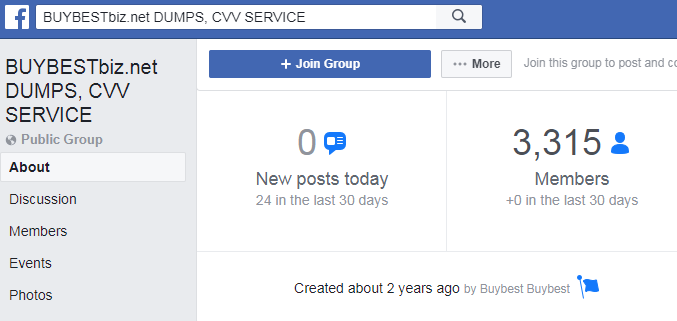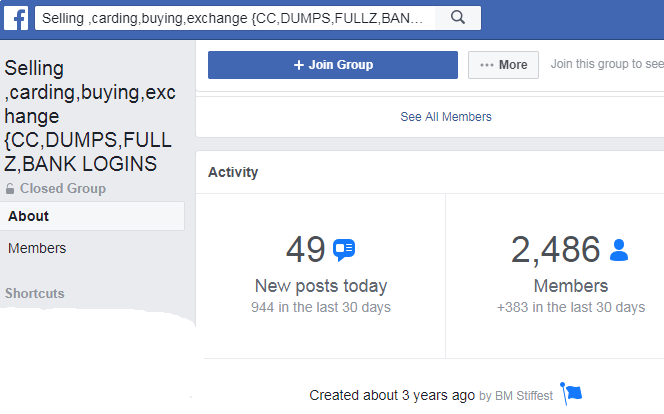Hours after being alerted by KrebsOnSecurity, Facebook last week deleted almost 120 private discussion groups totaling more than 300,000 members who flagrantly promoted a host of illicit activities on the social media network’s platform. The scam groups facilitated a broad spectrum of shady activities, including spamming, wire fraud, account takeovers, phony tax refunds, 419 scams, denial-of-service attack-for-hire services and botnet creation tools. The average age of these groups on Facebook’s platform was two years.
On Thursday, April 12, KrebsOnSecurity spent roughly two hours combing Facebook for groups whose sole purpose appeared to be flouting the company’s terms of service agreement about what types of content it will or will not tolerate on its platform.

One of nearly 120 different closed cybercrime groups operating on Facebook that were deleted late last week. In total, there were more than 300,000 members of these groups. The average age of these groups was two years, but some had existed for up to nine years on Facebook
My research centered on groups whose singular focus was promoting all manner of cyber fraud, but most especially those engaged in identity theft, spamming, account takeovers and credit card fraud. Virtually all of these groups advertised their intent by stating well-know terms of fraud in their group names, such as “botnet helpdesk,” “spamming,” “carding” (referring to credit card fraud), “DDoS” (distributed denial-of-service attacks), “tax refund fraud,” and account takeovers.
Each of these closed groups solicited new members to engage in a variety of shady activities. Some had existed on Facebook for up to nine years; approximately ten percent of them had plied their trade on the social network for more than four years.
Here is a spreadsheet (PDF) listing all of the offending groups reported, including: Their stated group names; the length of time they were present on Facebook; the number of members; whether the group was promoting a third-party site on the dark or clear Web; and a link to the offending group. A copy of the same spreadsheet in .csv format is available here.
The biggest collection of groups banned last week were those promoting the sale and use of stolen credit and debit card accounts. The next largest collection of groups included those facilitating account takeovers — methods for mass-hacking emails and passwords for countless online accounts such Amazon, Google, Netflix, PayPal, as well as a host of online banking services.

This rather active Facebook group, which specialized in identity theft and selling stolen bank account logins, was active for roughly three years and had approximately 2,500 members.
In a statement to KrebsOnSecurity, Facebook pledged to be more proactive about policing its network for these types of groups.
“We thank Mr. Krebs for bringing these groups to our attention, we removed them as soon as we investigated,” said Pete Voss, Facebook’s communications director. “We investigated these groups as soon as we were aware of the report, and once we confirmed that they violated our Community Standards, we disabled them and removed the group admins. We encourage our community to report anything they see that they don’t think should be in Facebook, so we can take swift action.”
KrebsOnSecurity’s research was far from exhaustive: For starters, I only looked at groups that promoted fraudulent activities in the English language. Also, I ignored groups that had fewer than 25 members. As such, there may well be hundreds or thousands of other groups who openly promote fraud as their purpose of membership but which achieve greater stealth by masking their intent with variations on or mispellings of different cyber fraud slang terms.
Facebook said its community standards policy does not allow the promotion or sale of illegal goods or services including credit card numbers or CVV numbers (stolen card details marketed for use in online fraud), and that once a violation is reported, its teams review a report and remove the offending post or group if it violates those policies.
The company added that Facebook users can report suspected violations by loading a group’s page, clicking “…” in the top right and selecting “Report Group”. Users who wish to learn more about reporting abusive groups can visit facebook.com/report.
“As technology improves, we will continue to look carefully at other ways to use automation,” Facebook’s statement concludes, responding to questions from KrebsOnSecurity about what steps it might take to more proactively scour its networks for abusive groups. “Of course, a lot of the work we do is very contextual, such as determining whether a particular comment is hateful or bullying. That’s why we have real people looking at those reports and making the decisions.”
Facebook’s stated newfound interest in cleaning up its platform comes as the social networking giant finds itself reeling from a scandal in which Cambridge Analytica, a political data firm, was found to have acquired access to private data on more than 50 million Facebook profiles — most of them scraped without user permission.
from
https://krebsonsecurity.com/2018/04/deleted-facebook-cybercrime-groups-had-300000-members/
No comments:
Post a Comment